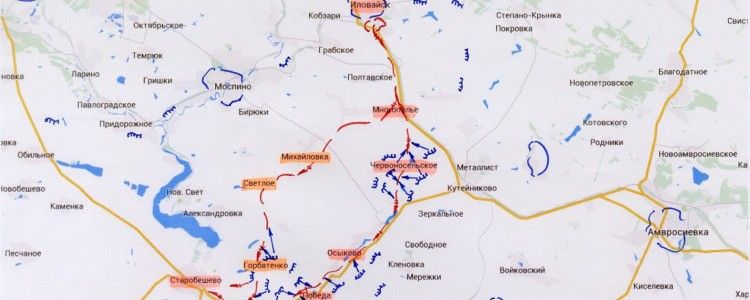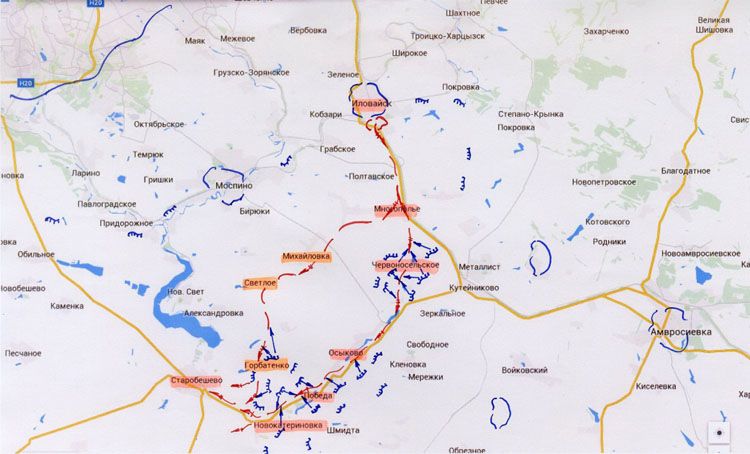

Two years ago, in the area surrounding the eastern Ukrainian...

Two years ago, in the area surrounding the eastern Ukrainian town of Ilovaisk tensions began to rise. A 4th Battalion tactical team went into the Donetsk Oblast via Amvrosiivka. The active phase of the fighting took place on August 25-26. The result was the defeat of the 4th unit of the 2nd Battalion of the 51st Brigade. Soldiers of the Ukrainian military infantry battalions and volunteer fighters tried to keep control of the highways but were eventually pushed back to Mnohopillya. Surrounded, it was the call of the commander of the sector, General Homchak who ordered troops to move closer to Ilovaisk and then control it by storming the settlement.
August 25 – the 11th Brigade is instructed to Fedorivka to hold the position for the approach of the tactical groups of the 30th Batallion. The group had come from Debaltseve and help liberate Ilovaisk together with an aggregated 92nd and 42nd brigade. The 30th Brigade failed to reach its destination. As a result, to Ilovaisk came only the 92nd Brigade. The 92nd consisted of 276 men: four T-64 tanks, three self-propelled guns, a dozen infantry fighting vehicles and trucks with fuel and ammunition.
August 27 – while heading for the settlement of Kolosky to rendezvous with a company from the 42nd Brigade, the 92nd Brigade was ambushed and entered into battle with Russian paratroopers, during which the group suffered extensive losses leading to the fighters abandoning vehicles and being pushed back. Before that artillery fire broke the column of the 42nd Brigade. As a result, the bid to capture Ilovaisk by the group failed.
The Command of the General Staff decided to postpone the group liberating Ilovaisk until September 1-2. Negotiations with the Russian side were conducted between General Muzhenko and his Russian equivalent Colonel-General Bogdanov.
August 28 – an agreement is reached on the withdrawal of volunteer battalions from Ilovaisk where they were at that time blocked. The Russians completed the deal, releasing the volunteers from Ilovaisk where they teamed up with the main Armed Forces in the area of Mnohopillya.
Bogdanov proposed a “green corridor”, but due to the fact that the parties could not reach an understanding on guarantees of the release of prisoners, Muzhenko on the night of August 29 contacted Homchak and informed him that without these guarantees no better solution will come and this was a breakthrough. Homchak informed him that he understood this stance and they would try to implement the issue at their level. At this time, a meeting of commanders ordered Vyacheslav Vlasenko (call sign Filin, the deputy battalion commander of “Donbas”) to go toward Mospino meaning the breakthrough was collectively ignored.
August 29 – at 8am in Mnohopillya two columns were formed, which were to travel two routes. In front of each column would be an APC flying a flag, one column travelled toward Starobesheve. There the Russian side exchanged prisoners for Russian paratroopers captured by the Ukrainian side.

Маршрути за якими виходили українські підрозділи від Іловайська в Старобешеве.
Around 8am, the column started came under fire from Russian mortars, Homchak ordered it continue. The first attack on the convoy was suffered when it passed near Chervonosilsk. Some fighters fled the enemy fire, went to the village and organized a Chervonosilske perimeter defense, its efforts led to the destruction of two enemy tanks, the capture of a Russian tank and the destruction of two BMDs and their crews. After days of negotiations, given the fact that in this group many prisoners were taken, the men eventually surrendered to the Russians.
The Ukrainian column’s exit came under a barrage of fire from both sides. Transport was the most affected and the soldiers began to go on foot or transferred to vehicles which were lucky not to succumb to the barrage. The column began to burn the land and General Homchak ordered five Tochka-U missiles to be fired on places where the enemy was expected to accumulate. Attempts were supplemented by 15 volleys of MLRS “Twister” rockets.called. link. Su-25, which effectively worked on the Russian units. According to some fighters, the column could come out only through a successful raid Su-25 in Russia’s position. One attack was shot down, but the pilot was able to eject and evacuated from the combat zone.
Also called in were Su-25 fighter jets, which effectively targetted Russian units. According to some fighters, the column could only move following a successful raid by a Su-25 on a Russian position. One attack jet was shot down, but the pilot was able to eject and was evacuated from the combat zone. However, all these efforts were not enough. Both columns were broken. General Homchak with a group of men spent three days moving out of the area only by night. About 400 men fell into captivity. Approximately 350 soldiers from the Ukrainian Armed Forces and volunteer battalions perished on this terrible day.
Russian troops took Komsomolsk and began to advance. Ukrainian artillery thundered across the front line. The Command of the General Staff sent all that was available to the front. In the raid went units of Ukrainian paratroopers who only recently left the already non-existent Sector D. Every day shots were exchanged, while a hastily set up operational headquarters to work on the adjustment of artillery worked around the clock to damage new targets.
August 31 – in the area around the settlement of Dokuchaevsk a concentration of enemy personnel and equipment was found. In order accumulate this military hardware and to eliminate the personnel a missile attack (TR-2) was launched, the results caused the tactical group battalion to lose efficiency.
September 1- during the night near the village of Novoazovsk a concentration of personnel and equipment of the enemy was detected. By joint decision between the missile troops and the ATO artillery headquarters a missile attack (TP-3) was launched, which resulted in lost tactical group efficiency. Some personnel and equipment were destroyed.
Progress against Russia slowed. In the rear, the Armed Forces raid team acted and their columns moved under constant risk of missile attack. The Ukrainian army was already demoralized and scattered, every day it inflicted significant losses.
The battle was waged until September 5, when the Minsk II agreement came into force. But the story did not end there …